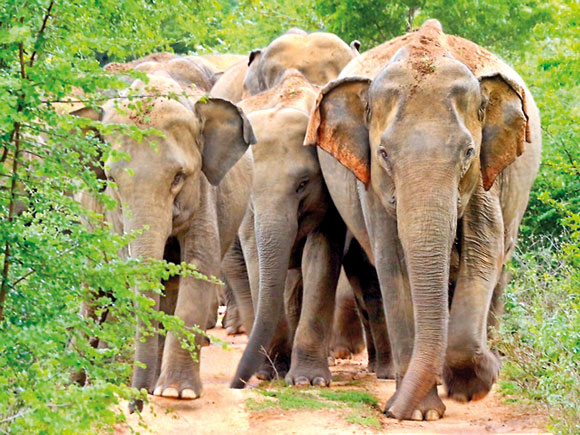Jun 10 2016.
views 783The Sri Lankan Elephant : A Treasure On Sale?
With the resignation of the Head of the Department of Wildlife Conservation (DWC) wildlife experts are raising concerns over several matters that are currently on the table. The human-elephant conflict has been a growing issue for many years, but conservationists were alarmed to learn the President himself has been pressured to request the DWC to issue permits to release elephants from the wild. Environmentalists say this is legally not possible and alleged that some private elephant owners have ‘misinformed’ the President about the current status of the non availability of elephants to be used in pereharas. Many conservationists say they are not against the use of elephants in pereharas but object to the treatment of the animals and point out that Pinnawela has sufficient animals for use, as Pinnawala elepahants have successfully given birth to almost 100 elephants calves since its beginning. Animal lovers also point out the absurdity in catching elephants in the wild and expecting the animal to perform at pereharas, as taming the elephant and separating elephants from their herd in the name of Buddhist culture seems to go against.

Sri Lanka faces a CITES trade suspension
The DML also learned due to the lack of legislation currently existing in terms of wildlife laws, Sri Lanka is facing a CITES trade suspension. The document clearly states that since Sri Lanka is still a Category 3 Party (and has been for 34 years) due to poor national legislation to implement CITES and has since then also been Party to the Convention, Sri Lanka will face "a suspension of commercial trade in specimens of CITES-listed species".
The document further notifies Sri Lanka while providing a final warning that if it fails to provide credible evidence of enacting appropriate legislation to put us into Category 1 by September 23rd 2016 at the 67th Standing Committee meeting, Sri Lanka will face a complete trade suspension of all CITES species.
In order to shed light on this issue, the DML spoke consulted the opinion of a few wildlife experts.
It is absurd to release elephants from the wild: Rukman Senanayake

The former Minister of Wildlife Rukman Senanayake said that during his tenure the government has never allowed anybody to capture elephants from the wild. “Our plan was to use elephants from Pinnawala. There were no permits to catch elephants from the wild when I was the Minister. However when we got a request to issue some elephants for the peraheras, we asked those who made the request to take elephants from Pinnawala because they are already tamed. There again we made it clear that only male elephants will be given for the peraheras since we had to take care of the female elephants for breeding purposes. It is absurd to release elephants from the wild and it is a violation of the law. Those who capture wild elephants are violating the Public Property Act and they should be prosecuted.”
Offenders of the Public Property Act should be punished : Jagath Gunawardena

Speaking to DML, environmental lawyer Jagath Gunawardena said that there is a Flora and Fauna Protection Ordinance that emphasizes on the legal possession of elephants. “Elephants belonging to the DWC could be legally possessed. But if any other elephant is possessed it is illegal. There is no provision for the President to request the DWC to release elephants from the wild. Those who own elephants from the wild are also offending the Public Property Act and they should be punished. Under the Section 22A, sub-section 12 of the Flora and Fauna Protection Ordinance, the property should be forfeited and the alleged people should be fined. There is no need to release elephants from the wild because there are many captive elephants in Pinnawala. These elephants could be used in peraheras. Also my other concern is that the same elephants that are being used for elephant rides to entertain tourists are being used to hold the Relic Casket at the auspicious peraheras. Isn’t that an insult to Buddhism?
Facts about elephant families
· Elephants are known for their superior intelligence as well as their structured social order. One of the main characteristics of the social order in the herd is that males and females live entirely different and separate lives.
· Elephants are a matriarchal society; that is, one that is led by a head cow, who presides over her herd of females. Each herd is made up of mothers, daughters, sisters and aunts. They are guided by the oldest and largest female of the herd. This herd sticks closely together, rejoicing at the birth of a calf and mourning at the death of a member.
· The herd of females, although maintaining close bonds among themselves, also interacts well with other herds, families, and clans. An average herd of immediate family will comprise of 5 to 15 adult elephants as well as immature males and females.
· The male, on the other hand, lives apart from the matriarchal herd, and travels alone or with other males in a bachelor pod. The drift from the herd starts during adolescence, at which time the young bulls start to spend less and less time with the herd. Eventually, the break is made completely. After this distance is established, the bulls will live solitary lives, mingling with the females of the family only for mating purposes.
· When one male split from all other company and becomes excessively aggressive and violent, he is known as the rogue male. He will usually win at any domination battles and, therefore, mate with more females than the other bulls. This means that his offspring are strong and that the herd enjoys fairly pure genes.
Source : www.elephantsforever.co.za/social-order.html

By Kamanthi Wickramasinghe
0 Comments